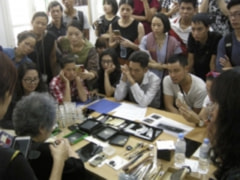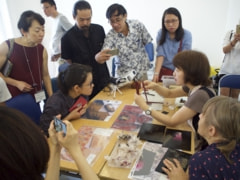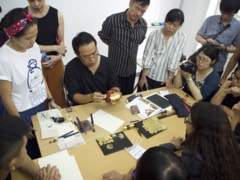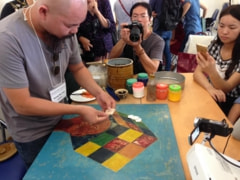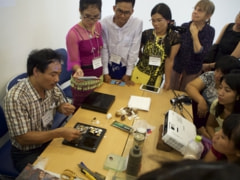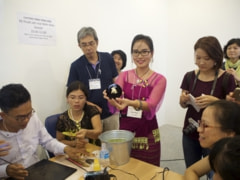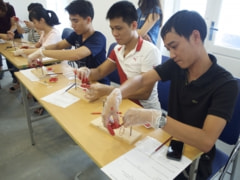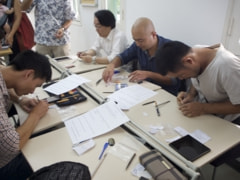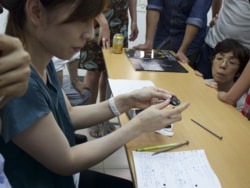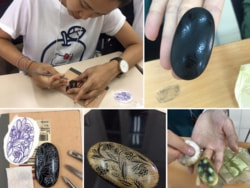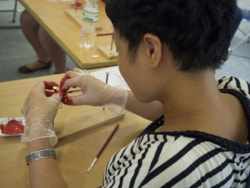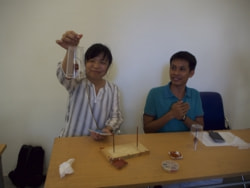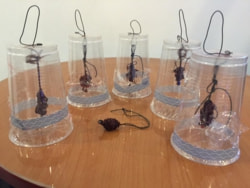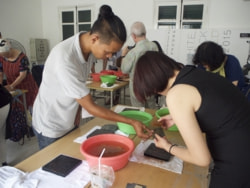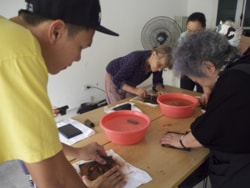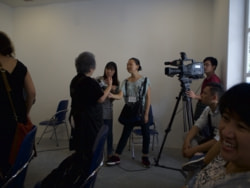Asian Lacquer Craft Exchange Program, in Hanoi, 2016
Exhibition | Lectures & Poster Session
Demonstrations
21 August, 10:00~12:00, the Japan Foundation Center for Cultural Exchange in Vietnam
ベトナム,日本, タイ, そしてミャンマーの漆芸技術について, 参加作家や技術者による技術公開を行った。
Vietnamese, Japanese, Thai and Myanmar lacquer techniques were demonstrated.
-Japanese Lacquer Technique, “Maki-e and Raden” 10:00~
Kagari Miyoshi, Lacquer Artist, Japan
日本の漆芸技法“蒔絵と螺鈿” 三好かがり 漆芸家
Ms. Kagari demonstrated several makie together with thin-shell and colored-shell raden techniques and exhibited the materials and tools used. She explained that while there are wonderful lacquer techniques in each country, the one that best represented Japan was makie. She demonstrated the wide range of expression that was possible by sprinkling silver and gold powder on urushi in combination with thin-shell and colored-shell raden techniques.
-Japanese Lacquer Technique “Kinma” 10:00~
Kayo Takahashi, Lacquer Artist, Japan
日本の漆芸技法“日本の蒟醤” 高橋香葉 漆芸家
“Kinma” technique is an urushi carving technique, which is called “kanyit” in Myanmar and “lai khut” in Thailand. Japan’s kinma uses colored urushi along with a number of carving techniques including line, dot, and weave carving. Besides demonstrating the process using several types of kinma tools, Ms. Takahashi showed photos of other techniques as well. She also demonstrated how the tools were sharpened and how charcoal abrasive was used to sand the urushi-filled patterns.
-Myanmar Lacquer Technique “Kanyit” 10:00~
Artisan, Bagan House Lacquerware Workshop, Bagan, Myanmar
ミャンマーの漆芸技法“蒟醤” バガンハウス
“Kanyit” is an etching technique similar to Japanese kinma. First the artisans demonstrated how the object is coated with acacia resin, then they etched the pattern is etched on the object. After that the object was coated with colored lacquer. After the lacquer dried, washing the object with water removed the acacia resin and the unwanted color. The color stayed only on the etched parts.
-Thai Lacquer Technique “Lai Kam Lanna” 11:00~
Lipikorn Makeaw, Assistance Professor, Rajamangala University of Technology Lanna
タイの漆芸技法 “ランナー箔絵技法” リピコン•マキャウ(ラジャマンガラランナー工科大学講師)
“Lai Kam Lanna” is gold leaf incising technique in Lanna Thai. This technique is also used in the Shan State and Laos in temple decoration. Professor Lipikorn first applied lacquer to the surface. Then he wiped it off and affixed gold leaf all over the surface. Using the sharp iron tool he drew a decorative pattern removing the gold leaf. A black lacquer motif appeared on the gold background.
-Vietnamese Lacquer Technique “Egg Shell and Shell Inlay and ” 11:00~
ベトナムの漆画技法 "卵殻と貝殻の螺鈿技術・絵画表現に使用する変わり塗り"(仕掛けの行程)画家 ドー・ドク・カイ
Aritst Do Duc Khai used eggshell and mother of pearl inlay as well as kawarinuri textures to demonstrate this Vietnamese lacquer painting technique.
-Vietnamese Lacquer Technique “Silver leaf, colored lacquer coating and sanding” 11:00~
ベトナムの漆画技法 "銀箔貼り・色漆塗り・研ぎ出し” 画家 チャン・フ―・ヴァン
Artist Tran Huu Van used silver leaf and colored lacquer coating to demonstrate a Vietnamese painting and sanding processs.
Workshops
21 August, 13:00~15:00, the Japan Foundation Center for Cultural Exchange in Vietnam
27 Quang Trung street, Hoan Kiem district, Hanoi URL: http://jpf.org.vn/en/
Vietnamese and Japanese lacquer techniques will be practiced.
日本とベトナムの漆技法を体験するワークショップを開催した。
- Japanese Lacquer Technique - Making a “Chinkin” brooch (for beginners) 13:00 ~ 15:00
Kanae Ako, Japanese lacquer artist
日本の漆芸技法“沈金技法によるブローチ作り” 吾子可苗 漆芸作家
“Chinkin” is a gold-inlaid lacquer decoration technique using gold powder or leaf in etched grooves. The technique originated in China during the Sung period (960–1279) and was later introduced into Japan. After the pattern has been incised into the lacquer surface with a fine chisel “chinkin-tou”, raw lacquer is rubbed into the grooves as an adhesive for gold powder or gold leaf pressed into them. In this workshop, simple chinkin techniques were practiced on 30 x 45 mm round pendant shapes.
- Urushi lacquered strap using string and gold leaf (for beginners) 13:00 ~ 15:00
Mitsumi Irahara, Japanese lacquer artist
“漆糸玉づくり” いらはらみつみ 漆芸作家
In ancient times people began using urushi (natural lacquer) as an adhesive. As the lacquer hardens it becomes a durable and protective layer. Over the centuries it became an important craft material. Urushi has been used to strengthen and ennoble utensils in daily life as well as for special ceremonial use. In this workshop, the participants made lacquered straps using string, beads, and gold leaf.
- Vietnamese Lacquer - Sanding and Polishing a complete Son Mai painting 13:00 ~ 15:00
Saeko Ando, Lacquer Painter, Vietnam
ベトナムの漆画 “ソンマイ画の研ぎ出しと磨き体験” 安藤彩英子 漆画家
Paticipants began with a Son Mai painting which already layers of silver leaf, shell powder, and colored lacquer applied to it. By sanding and polishing the painting, participants practiced the process of bringing out and transform features of the Son Mai painting; a process that usually takes many days.
